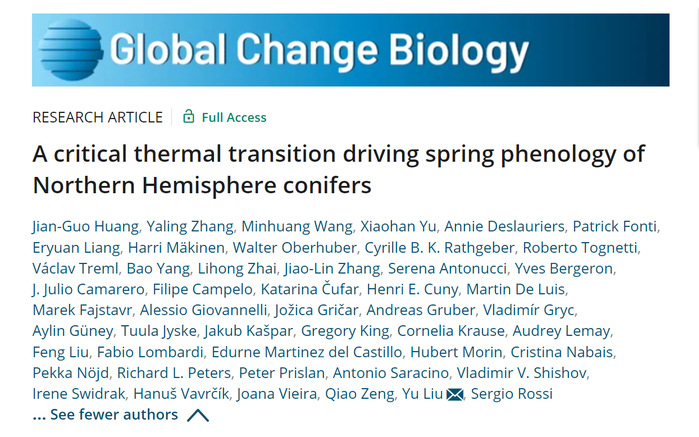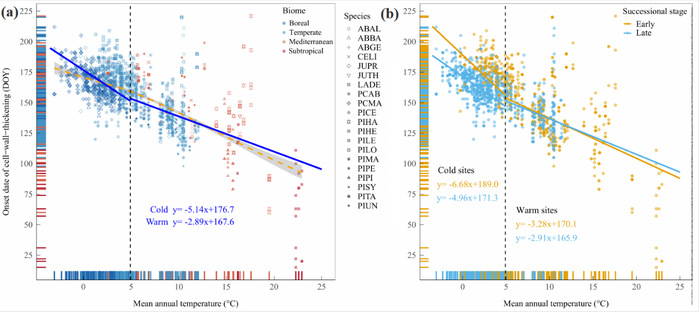
Title: A critical thermal transition driving spring phenology of Northern Hemisphere conifers
Jian-Guo Huang, Yaling Zhang, Minhuang Wang, Xiaohan Yu, Annie Deslauriers, Patrick Fonti, Eryuan Liang, Harri Mäkinen, Walter Oberhuber, Cyrille B. K. Rathgeber, Roberto Tognetti, Václav Treml, Bao Yang, Lihong Zhai, Jiao-Lin Zhang, Serena Antonucci, Yves Bergeron, J. Julio Camarero, Filipe Campelo, Katarina Čufar, Henri E. Cuny, Martin De Luis, Marek Fajstavr, Alessio Giovannelli, Jožica Gričar, Andreas Gruber, Vladimír Gryc, Aylin Güney, Tuula Jyske, Jakub Kašpar, Gregory King, Cornelia Krause, Audrey Lemay, Feng Liu, Fabio Lombardi, Edurne Martinez del Castillo, Hubert Morin, Cristina Nabais, Pekka Nöjd, Richard L. Peters, Peter Prislan, Antonio Saracino, Vladimir V. Shishov, Irene Swidrak, Hanuš Vavrčík, Joana Vieira, Qiao Zeng, Yu Liu, Sergio Rossi
First published: 30 November 2022
https://doi.org/10.1111/gcb.16543
Abstract
Despite growing interest in predicting plant phenological shifts, advanced spring phenology by global climate change remains debated. Evidence documenting either small or large advancement of spring phenology to rising temperature over the spatio-temporal scales implies a potential existence of a thermal threshold in the responses of forests to global warming. We collected a unique dataset of xylem cell-wall-thickening onset dates in 20 coniferous species covering a broad mean annual temperature (MAT) gradient (-3.05 to 22.9°C) across the Northern Hemisphere (latitudes 23-66°N). Along the MAT gradient, we identified a threshold temperature (using segmented regression) of 4.9±1.1°C, above which the response of xylem phenology to rising temperatures significantly decline. This threshold separates the Northern Hemisphere conifers into cold and warm thermal niches, with MAT and spring forcing being the primary drivers for the onset dates (estimated by linear and Bayesian mixed-effect models), respectively. The identified thermal threshold should be integrated into the Earth-System-Models for a better understanding of spring phenology in response to global warming and an improved prediction of global climate-carbon feedbacks.
Link: https://onlinelibrary.wiley.com/doi/10.1111/gcb.16543






